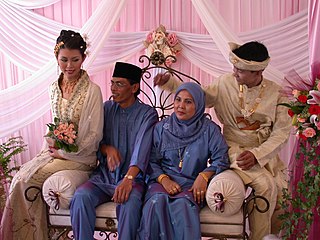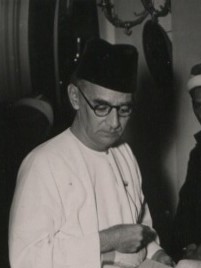
Johor Bahru, colloquially referred to as JB, is the capital city of the state of Johor, Malaysia. It is located at the southern end of Peninsular Malaysia, along the north bank of the Straits of Johor, opposite the city-state Singapore. The city has a population of 858,118 people within an area of 391.25 km2. Johor Bahru is adjacent to the city of Iskandar Puteri and Pasir Gudang, together with their surrounding areas anchoring Malaysia's second largest urban agglomeration, Iskandar Malaysia, with a population of 2,246,712.

The Batu Pahat District is a district in the state of Johor, Malaysia. It lies southeast of Muar, southwest of Kluang, northwest of Pontian, south of Segamat and Tangkak District. The capital of the district is Bandar Penggaram.

Malay Singaporeans are a local ethnic group in Singapore. The group is defined as a Singaporean who is of Malay ethnicity or, whose ancestry originates from the Malay world. Malay Singaporeans constitute approximately 15% of the country's citizens, making them the second largest ethnic group in Singapore after Chinese Singaporeans and before Indian Singaporeans. They are recognised by the government as an indigenous people of the country.

The Johor Sultanate was founded by Malaccan Sultan Mahmud Shah's son, Sultan Alauddin Riayat Shah II in 1528. Johor was part of the Malaccan Sultanate before the Portuguese conquered Malacca's capital in 1511. At its height, the sultanate controlled modern-day Johor, Pahang, Terengganu, and territories stretching from the river Klang to the Linggi and Tanjung Tuan, Muar, Batu Pahat, Singapore, Pulau Tinggi and other islands off the east coast of the Malay peninsula, the Karimun islands, the islands of Bintan, Bulang, Lingga and Bunguran, and Bengkalis, Kampar and Siak in Sumatra. During the colonial era, the mainland part was administered by the British, and the insular part by the Dutch, thus breaking up the sultanate into Johor and Riau. In 1946, the British section became part of the Malayan Union. Two years later, it joined the Federation of Malaya and subsequently, the Federation of Malaysia in 1963. In 1949, the Dutch section became part of Indonesia.

Dato' Sir Onn bin Dato' Jaafar was a Malayan politician who served as the 7th Menteri Besar of Johor from 1947 to 1950, then Malaya. His organised opposition towards the creation of the Malayan Union led him to form the United Malays National Organisation (UMNO) in 1946; he was UMNO's founder and its first President until his resignation in 1951. He was famously known as the pioneer of organised anti-imperialism and early Malay nationalism within the entire Malaya, which eventually culminated with the Malayan independence from Britain. He was also responsible for the social and economic welfare of the Malays by setting up the Rural Industrial Development Authority (RIDA).

Pontian District is a district located in southwest part of the Malaysian state of Johor. It borders Batu Pahat and Kluang Districts to the north and Kulai and Johor Bahru Districts to the east.

Pontian Kechil also known as Pontian Town is a town and the administrative centre of Pontian District, Johor, Malaysia.

Sungai Balang is a mukim in Muar District, Johor, Malaysia. It is located on Federal Route 5. Its name literally means Balang River.
Kampong Nong Chik or "Nong Chik Village" is a Malay neighbourhood located in the city of Johor Bahru, Johor, Malaysia.

The Kulai District is a district in the state of Johor, Malaysia. Its district capital is Kulai Town. It covers Kulai Town, Ayer Bemban, Bandar Putra Kulai, Bukit Batu, Indahpura, Bandar Baru Kangkar Pulai, Kelapa Sawit, Saleng, Sedenak, Seelong, Senai, and Sengkang. Kulai is also within Iskandar Malaysia economic zone.
The Pulau Pisang Lighthouse is a lighthouse located on the highest point of Pulau Pisang, an island in the Strait of Malacca 15 kilometres from Pontian Kechil, Johor, Malaysia.

Muar or Bandar Maharani, is a historical town and the capital of Muar District, Johor, Malaysia. It is one of the most popular tourist attractions in Malaysia to be visited and explored for its food, coffee and historical prewar buildings. It was recently declared as the royal town of Johor by Sultan Ibrahim Sultan Iskandar and is the fourth largest urban area in Johor. It is the main and biggest town of the bigger entity region or area of the same name, Muar which is sub-divided into the Muar district and the new Tangkak district, which was upgraded into a full-fledged district from the Tangkak sub-district earlier. Muar district as the only district covering the whole area formerly borders Malacca in the northern part. Upon the upgrading of Tangkak district, the Muar district now covers only the area south of Sungai Muar, whilst the northern area beyond the river is in within Tangkak district. However, both divided administrative districts are still collectively and fondly called and referred to as the region or area of Muar as a whole by their residents and outsiders. Currently, the new township of Muar is located in the Bakri area.

Iskandar Malaysia, formerly known as Iskandar Development Region (IDR; Malay: Wilayah Pembangunan Iskandar) and South Johor Economic Region (SJER), is the main southern development corridor in Johor, Malaysia. It was established on 8 November 2006. Iskandar Malaysia, which is formed by major cities such as Johor Bahru, Iskandar Puteri, Pasir Gudang, together with their surrounding areas, is Malaysia's second largest urban agglomeration with a population of 2,500,000, after Greater Kuala Lumpur.
The family of Al-Saggoff were Arab Singaporean spice traders of Hadhrami origin, who became influential by marrying into a royal family from the Celebes. They acquired many properties, like the other Arab families, including the "Perseverance Estate" where they grew lemon grass. The estate is now considered to be the heart of the Muslim community in Singapore, with the Alsagoff family still retaining its prominence there. They originally belong to the Ba'Alawi clan of the Bani Hashim in Hadhramaut. Hence, they are a Ba'Alawi Sayyid family. Then-master-chef of the family, Mr. Abdul-Rahman established a restaurant named "Islamic" in 1921 in Singapore, which is functioning till date. As well as being successful merchants and land owners, the family became involved in civic affairs. The family members, at times, held civic office from the 1870s, until Singaporean independence in 1965.
Tan Sri Dato’ Haji Anwar bin Haji Abdul Malik (1898–1998) was a Malaysian politician. Anwar along with, Dato' Onn Jaafar, Tan Sri Mohamed Noah Omar, Haji Syed Alwi bin Syed Sheikh al-Hadi and Dato' Syed Abdul Kadir Mohamed formed the United Malays National Organisation to counter the Malayan Union that was undermining the Malay Sultans's powers and threatened the Malays of their rights as Bumiputera.
Syed Mohamed bin Syed Ahmad Alsagoff was an Hadhrami Muslim born in Singapore who was known as Nong Chik.

Johor, also spelled as Johore, is a state of Malaysia in the south of the Malay Peninsula. Johor has land borders with the Malaysian states of Pahang to the north and Malacca and Negeri Sembilan to the northwest. Johor shares maritime borders with Singapore to the south and Indonesia to both the west and east. Johor Bahru is the capital city and the economic centre of the state, Kota Iskandar is the seat of the state government, and Muar serves as the royal capital of the state. Johor Lama served as the old state capital during the period of the Johor Sultanate. As of 2020, the state's population is 4.01 million, making it the second most populated state in Malaysia. Johor has highly diverse tropical rainforests and an equatorial climate. Situated at the southern foothills of the Tenasserim Hills, inselbergs and massifs dominate the state's flat landscape, with Mount Ledang being the highest point. Johor Bahru is one of the anchor cities of the Iskandar Malaysia development corridor, which is one of the most densely populated and fastest-growing urban areas in Malaysia.
The Iskandar Coastal Highway (ICH) (formerly Johor Bahru West Coast Parkway) (Malay: Lebuhraya Pesisir Pantai Iskandar (LPPI)) or the stretch of road that includes Lebuhraya Sultan Iskandar, Persiaran Sultan Abu Bakar (formerly Jalan Skudai, Jalan Abu Bakar) and Persiaran Sultan Ismail (formerly Jalan Ibrahim and Persiaran Tun Sri Lanang) (Federal Route 52 (Iskandar Puteri–Danga Bay) and Johor State Route 1 (Danga Bay–City Centre)) is a highway in Johor Bahru District, Johor, Malaysia. The 23 km (14 mi) highway connects Iskandar Puteri in the west to Johor Bahru in the east. It is a toll free highway and part of the Iskandar Malaysia project. The Iskandar Coastal Highway is the fifth east–west-oriented expressway in the Iskandar Malaysia area after the Pasir Gudang Highway, the Pontian–Johor Bahru Link of the Second Link Expressway, the Senai–Desaru Expressway and the Johor Bahru East Coast Highway.

Orang Seletar are one of the 18 Orang Asli ethnic groups in Malaysia. They are classified under the Proto-Malay people group, which forms the three major people group of the Orang Asli. The Orang Seletar are also considered as part of the Orang Laut, natives of the Straits of Johor; separating Singapore from Peninsula Malaysia.
















